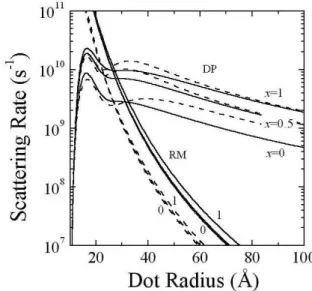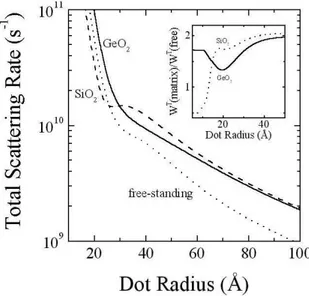Eletron-Aousti Phonon Sattering Rates in Spherial
Quantum Dots: Contribution of the Marosopi
Deformation Potential
A. M. Alalde, G.E. Marques,
Departamento deFsia,UFSCar,CaixaPostal676, 13565-905S~aoCarlosSP,Brazil
G.Weber,
UniversidadeS~ao Franiso,13251-900 ItatibaSP,Brazil
and T. L.Reineke
NavalResearh Laboratory,Washington, D.C.20375, USA
Reeivedon23April,2001
Theeletron{aousti-phononsatteringproessinspherialII-VIquantumdotsisdisussed. The
quantized aousti modes are desribed in termsof the Lamb's lassial theory. We onsidered
twomehanismfortheinterationbetweeneletronsandaoustimodes: mirosopideformation
potential,andmarosopiaoustideformation,alsoalledtheripplemehanism. Wealsodisuss
theinueneofthe glassmatrixonthe eletron-phononoupling. Ouralulations showthat the
ripplemehanismsatteringratesbeomedominantbymorethananorderofmagnitude,forsmall
dotradius. Ingeneral,the total satteringratedepends onthe aoustial propertiesof theglass
matrix.
The eletron-phonon interation ontrols a wide
range of phenomena suh as the ooling of optially
exitedarrierson thepioseondtimesale [1, 2℄. In
aquantumdotsystem,theroleoftheeletron-phonon
interationonaarrierrelaxationproesshasbeen
dis-ussed in termsof possibleslowing of relaxationrates
due totheeets ofonnement,in partiular,onthe
phonon system. The physial mehanisms underlying
arrierrelaxationareyetnotfullyunderstood. In
par-tiular there is urrently some debate related to the
phonon bottlenek eet, espeially regarding its
ap-parentabseneinsmallII-VIquantumdots. Therefore,
itisneessarythat alternativearrierrelaxationpaths
shouldbedisussedsystematially. Inthiswork,we
al-ulatetheeletron{aousti-phononsatteringratesin
CdS
1 x Se
x
spherialquantumdotsembeddedinaglass
matrix. The aoustimodesare desribed in termsof
theLamb'slassialtheoryoftheosillationsofa
on-tinuous elasti sphere [3, 4, 5℄. This model is valid if
thewavelengthsoftheaoustiphononsaresuÆiently
largerthanthelattieonstantsofthesemiondutor.
ForthePoissononstantsonsideredinthiswork,this
onditionisreasonablyvalid. We haveonsidered two
mehanisms for the eletron-phonon interation: The
mirosopideformationpotential(MDP)andthe
rip-plemehanism(RM)[6,7℄,whihresultsfromthetime
dependent modulationsoftheinterfae. Theeetsof
theouplingofthephononsofaquantumdotwiththe
surroundingmatrixarealsodisussedhere.
In semiondutor nanorystals, the aoustial
modes beome disrete due to the size quantization.
Their properties anbedesribed in terms of Lamb's
lassialtheoryoftheosillationsofaontinuous
elas-ti sphere. If the nanorystal shape is supposed to
be spherial, Lamb theory predits the existene of
two elasti osillations leading to torsional and
om-pressionalmodes. Thepurelyompressionalmodehas
speial interest sine it providesthe dominant
ontri-bution to the aousti phonon deformation potential.
We restrit our attention to theRaman ative
aous-tial modes. Duval et al. [4℄ have determined that
only modes with l = 0;2, an ontribute to the
Ra-man sattering of the light in rst order. The
low-est order spheroidalmode, l= m =0, is often alled
thebreathingmode. This modeprovidesthedominant
ontribution in the sattering proess. The breathing
mode displaement inside the dot is purely
longitudi-nalandthedotsizedependene oftheirfrequenies!
k
an be alulated by onsidering the inuene of the
surfaeonthephonondisplaements. Thisinueneis
addressedbymeansoftwomehanialboundary
ondi-tions: i)Stress-free boundaryondition, meaningthat
ii) Rigid boundary onditionwhih demands that the
omponentsof thedisplaementvanish on thesurfae
ofthemirorystal. WewillfollowtheworkofOvsyuk
andNvikov[8℄toalulatetheinueneofa
surround-ing glass matrix on the breathing mode. The most
remarkable fats assoiated with the inuene of the
glass matrixare: i) Thepresene ofthe glassleadsto
adereaseofthephononenergywhenthevaluesofthe
Lame'sonstantsandandthemassdensitiesare
verydierentbetweenthesemiondutorandglass
ma-trix media and, ii) Theappearane of anew solution
assoiatedwithsurfaeorinterfaemodes.
In our alulations, the usual form of the MDP
Hamiltonianisonsidered,wherethemainontribution
isgivenbyDru,whereDisthedeformationpotential
oupling onstant. Note that, under these onditions,
onlylongitudinalaoustimodesanoupletothe
ar-riers. FortheRM,wewillusetheproedureillustrated
by Knipp and Reineke [6℄. By onsidering that this
eletron-phononouplingmehanismarisesfroma
per-turbationoftheeletroniwavefuntionduetothe
mo-tionof theinterfaes,itanbeshownthat the
impor-tanttermsfortheripple modes arethosethat possess
spatialdependeneonthepotentialenergyV(r)andon
the eetive massm(r). The interation Hamiltonian
isalulatedseparatelyforeahonebyusingan
expan-sioninTaylorseriesforsmallaoustialdisplaements.
Wealulate the transition rateW for aneletron
be sattered from an initial state i to anal state f,
aompanied by the emission of anaoustial phonon
haraterizedbythefrequeny!
k
byusingthe
follow-ingexpression
W
i!f =
2
~ jM
i!f (k)j
2
Æ(E
i E
f ~!
k );
where M are the matrix elements of the
eletron-phonon interation involvedin thetransition. We use
the approahproposed byVurgaftman and Singh[10℄
whihallowustoinludethespetralbroadeningofthe
eletroni spetraduetoaniteenergylevellifetime.
In our alulations, the eletroni levels are
de-sribedfollowingthework ofEkimovet al., [11℄. The
material onstants employed for this system are
ob-tainedthroughlinearinterpolationfrom theCdSeand
CdS bulkparameters. Wewillrestritouralulations
to eletroni transitionsbetweenthe rstexited level
andthegroundstate.
First, we alulate the sattering rates for
free-standingquantumdotsonsideringboththestress-free
and the rigidboundaryonditions. Ourresults, allow
ustoestablishsomequalitativedierenesintherates
duetothepossiblehoiesoftheboundaryonditions.
Aweakdependeneofsatteringonthemodefrequeny
is observedin rates assoiated to MDP. The onned
in the osillations as the dot radius inreases. This
satteringproessispratiallyindependentof
bound-aryondition,mainlywhenthespatialonnement
de-reases. Inontrast,therelaxationratesassoiated to
RM depend strongly on the frequeny of the modes.
Asitshouldbeexpeted,theuseoftherigidboundary
ondition,(meaningrigidinterfae) neutralizesalmost
ompletelythe ripple eet,whih is essentiallybased
onanmarosopiperturbationof theinterfaes. Our
results reprodue the behavior presented in previous
works for aousti bulk modes [6, 7℄, and they show
that theRM is the main hannel of arrier sattering
in small size systems. This situation may be
under-stood by making ananalogywith the behaviorof the
levelsinanarrowquantum well,where theposition of
the levels is more aeted by the hange in the well
width(marosopi)thanforahange inthegap
(mi-rosopi).
IntheFig.1,weshowntheeetoftheglassmatrix
onthe transition ratesfor RM and MDP. Theresults
alsoshowratesforonentrationsx=0(CdS),x=0:5
andx=1(CdSe).
Figure 1. Eletron{aousti-phonon sattering rates in
CdS1 xSex as afuntionof dot radius R . MDPand RM
ontributionsare inluded. Theeets ofSi02 (Ge02)
ma-trixareshowedinsolid(dashed)lines.
Two importantharateristis anbeobserved for
theRMrate. First,asinthefree-standingdots,itis
ob-servedthattherippleratesarestronglysensitivetothe
variationsofthe phonon frequenies. Now, thesoure
ofthefrequenyhangesarerelated withthepresene
of the glass matrix. Also, for the whole range of dot
radiionsidered,weverifythat thealulatedratesfor
dotsinSiO
2
matriesarelargerthantheratesfordots
inGeO
2
matries. Thislastfatisadiretonsequene
of thesoftening ofthe phonon frequeny modes when
Thebehaviorof therates an beexplained by
ob-serving that, due to the phonon normalization, both
theMDPandtheRMouplingsdependinverselywith
thesquarerootofthefrequenyu1= p
!. Therefore,
a derease in thefrequeny produes an inrement in
RMouplingandonsequentlyaninreaseintheir
or-respondingtransitionrates. Notethattheparameter
1
measuresthedegreeofdereaseofthebreathingmode
frequenies[8℄. Thefrequenydereaseswhenthevalue
of
1
beomesgreaterthan1. FortheGeO
2
,thevalue
of the parameter
1
is 0.99, while for the SiO
2 it is
approximately1.3.
Figure 2. Total eletron{aousti-phonon sattering rates
inCdSequantumdots. Stress-freeboundaryonditionwas
used in this alulation. Inset shows the ratio between
the total rate for a CdSe dot embedded in a glass
ma-trix[W T
(matrix)℄andthetotalrateforafree-standingdot
[W T
(free)℄.
InFig.2weshowthedependeneofthetotal
sat-tering rates as a funtion of the radius of the CdSe
quantum dot for two dierent glass matries (SiO
2 ,
GeO
2
). Thetotalsatteringrateforafree-standingdot
is also represented in dotted lines. Stress-free
bound-aryonditionswereusedforthisalulation. Therapid
inrease of the total sattering rates in the small dot
sizes regime is due to the inuene of the RM. This
eet ould explain the results of Klimov et al. [13℄,
who has observed that at small dots (radii less than
40
A) the measured relaxationtimes inrease linearly
withtheradius. Thisobservation annotbeexplained
fromargumentsthatinluderelaxationassistedby
op-tial phonons. The eet of the glass matrix an be
better illustratedin the inset of the Fig. 2, where we
displaytheratioofthetotalsatteringrateforaCdSe
dotembedded inaglassmatrixtothetotalsattering
rateforafree-standingdot[W T
(matrix)/W T
(free)℄.In
general,absolutevariationsoftheorder75-100%anbe
observed. Weanalsoobservethat forsmalldotsizes,
where the ontributionof the RMon thetotal rateis
morevisible. However,forsize dotsgreaterthan80
A,
the eet of the matrix and therefore of the RM
be-omesalmostnegligible.
Although we onsidered only breathing modes in
thiswork,theaboveonsiderationsanbeextendedto
other phonon modes. However, we believe that if we
onsider aousti modes with l > 0, the relative
im-portane of theRMshould beome graduallysmaller,
sinetheaoustifrequeniesinreaselinearlywiththe
angularmomentl. Thishangeinthemodefrequenies
wouldprodueasmallerouplingviaRM.
In onlusion, we note that the main sattering
hannel for aousti modes arises mainly through the
MDP. Ourresults alsodemonstrate that theinlusion
oftheRMshouldbeonsideredmainlyinsmalldotsize
systems. Finally, it is lear that thesurrounding
ma-terial plays asigniantrole in the
eletron{aousti-phonon oupling, andits eets should be inludedin
theanalysisoftherelaxationproesses.
Aknowledgments
ThisworkhasbeensupportedbyFunda~aode
Am-paro a Pesquisa do Estado de S~ao Paulo (FAPESP),
Conselho de Desenvolvimento CientoeTenologio
(CNPq), PEPCI/USFand bytheU.S.OÆe ofNaval
Researh.
Referenes
[1℄ A. M. Alalde,G. E. Marques, G.Weber, and T. L.
Reineke,SolidStateCommun.116,247(2000).
[2℄ A.M. Alaldeand G.Weber,Semiond.Si. Tehnol.
15,1082(2000).
[3℄ T.Takagahara,J.Lumin.70,129(1996).
[4℄ E. Duval, A. Boukenter, and A. Champagnon, Phys.
Rev.Lett.56,2052 (1986).
[5℄ L. Saviot et al., J. Non-Crystalline Solids 197, 238
(1996).
[6℄ P.A.KnippandT.L.Reineke,Phys.Rev.B52,5923
(1995).
[7℄ F. T. Vasko and V. Mitin, Phys. Rev. B 52, 1500
(1995).
[8℄ N. N. Ovsyukand V. N. Novikov, Phys.Rev. B 53,
3113(1996).
[9℄ A.Tamura,K.Higeta,andT.Ihinokawa,J.Phys.C:
SolidStatePhys.15,4975(1982).
[10℄ I.VurgaftmanandJ.Singh,Appl.Phys.Lett.64,232
(1994).
[11℄ A.I.Ekimovetal.,J.Opt.So.Am.B10,100(1993).
[12℄ U.BokelmannandG.Bastard,Phys.Rev.B42,8947
(1990).
[13℄ V.I.Klimov,D.W.MBranh,C.A.Leatherdale,and

